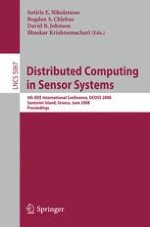The book constitutes the refereed proceedings of the 4th International Conference on Distributed Computing in Sensor Systems, DCOSS 2008, held on Santorini Island, Greece, in June 2008.
The 29 revised full papers and 12 revised short papers presented were carefully reviewed and selected from 116 submissions. The papers propose a multitude of novel algorithmic design and analysis techniques, systematic approaches and application development methodologies for distributed sensor networking. The papers cover aspects including energy management, communication, coverage and tracking, time synchronization and scheduling, key establishment and authentication, compression, medium access control, code update, and mobility.
